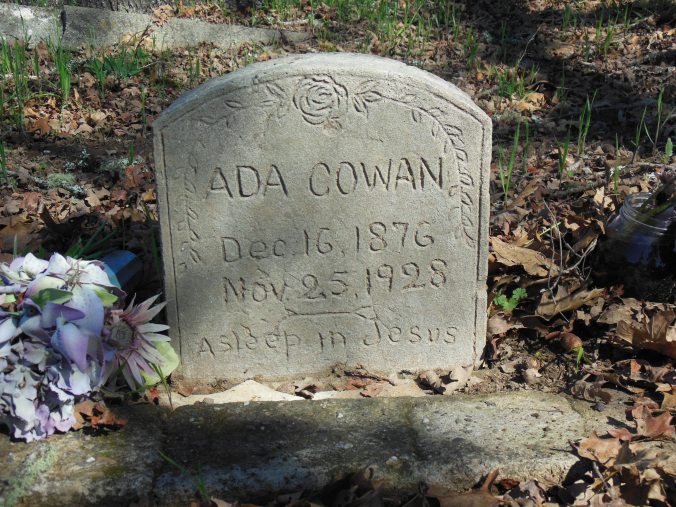We’ve taken Ada Mae’s story up through about 1920, where we find her in Kitsap County, Washington, living with her husband Joseph Edgar Cowan, her step-son Louis, her daughters Reah, Pearl, and Ellen, and her son Walter. She’d lived in Washington since her parents moved there in 1886, and her networks, as far as I knew, were there and in the Midwest.
But what I couldn’t figure out for the longest time was why, in 1928, she died in Sonoma County, California, and was buried there under a simple cement headstone, among strangers.

By the 1930 U.S. Federal Census, her family had scattered. Reah and Louis we now know were living in northern Washington. Ellen was living with her aunt Phebe (Ada Mae’s sister) and family in Oregon. Pearl was also married and living elsewhere in Oregon, with her 11-year-old brother Walter in her house. Joseph Edgar had taken off to Alaska, where his son Clyde was living with wife and family, and only Joseph’s son Dallas, also married, remained in Kitsap County. Just looking census to census, it looked like a bomb had gone off in the lives of Ada Mae’s family. But the 10-year gap between censuses can obscure so much.
I had learned to see the Scotts as tribal folk, moving primarily among established family networks. (I’ve always been inclined to credit this to their Scots-Irish origins.) And I could not for the life of me figure out what she was doing in California, since the family had no history there. Finally, a cousin supplied the missing piece — naval yards.
Military families probably would have spotted this a lot sooner, but my family wasn’t, as such, a naval family — at least not until Walter joined up in 1937. But when I realized what I was looking at, it was all there.
- The 1910 US Census reports Joseph Edgar Cowan and Clyde Cowan as General Day Laborers, but Louis Cowan is a Navy Yard Teamster, and Dallas Cowan is a General Teamster.
- The 1920 US Census reports Joseph Edgar Cowan and Louis Cowan both as Navy Yard Laborers, and it lists Dallas Cowan as an Acetylene Operator at the Navy Yard.
- Kitsap County was home to a port and naval shipyard at Bremerton, WA.
- On 29 April 1927, Ada Mae’s daughter Pearl (who had married Silas Thomas Clark at some point between 1920 and 1927), gave birth to a son, Boyd Thomas Clark, in Graton, Sonoma County, CA.
- On 5 December 1928, Ada Mae’s sister Phebe (who married George Earl McKay in 1909), gave birth to a son, Billy George McKay, also in Graton, Sonoma County, CA.
- Sonoma County was then home to the Naval Auxiliary Air Station in Santa Rosa, CA.
As far as I can tell, neither Silas Thomas Clark or George Earl McKay ever served (and the latter appears to have eventually become a Church of Christ minister) but the naval bases seem to have given them a reason to be there, at least for a time. By 1930, both families had returned to the Pacific Northwest.
But in the fall of 1928, Ada Mae’s daughter had a toddler whom she’d likely never met, her sister was about to deliver, and both were in Sonoma County. That’s two families getting by on laborers’ wages, the latter already with six kids, not counting the baby that arrived 10 days after Ada Mae’s death. No one was expecting to have to pay for a burial/funeral, least of all Ada Mae.
When I was growing up, my father used to tell me about how Ada Mae’s children had been itinerant fruit pickers, among other things, during (and even before?) the Depression. But the picture I get is very much that they went where the work took them, keeping family close as best they possibly could. And like most itinerant poor families, they buried their dead when and where they could, even as they knew they’d have to move on. “Asleep in Jesus” — they must have found such comfort in their faith, knowing that, in whatever way, she wasn’t really alone.
Ada Mae’s story is a good reminder how easy it is for ordinary folks to be lost in the flow of history. But it also serves as a reminder for me of why I do what I do. There’s an internet meme that asks respondents to “Explain your job/hobby awkwardly.” My response is usually something like, “I sort through digital representations of stained plant matter and etched rocks until I can let the living claim the dead as their own,” yet there’s more to it than that. I also give the living closure, when I can, about the wounds of their dead. My father always wondered why Ada Mae was in a pauper’s grave so far from home, and now we know — she died caring for those who had to wander. RIP, Ada Mae.